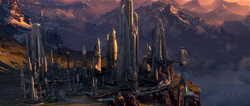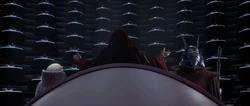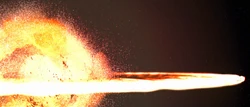mNo edit summary |
mNo edit summary |
||
| Line 296: | Line 296: | ||
*''[[Star Wars 70: Rebels and Rogues, Part III]]'' |
*''[[Star Wars 70: Rebels and Rogues, Part III]]'' |
||
*''[[Star Wars 71: Rebels and Rogues, Part IV]]'' |
*''[[Star Wars 71: Rebels and Rogues, Part IV]]'' |
||
| + | *''[[Star Wars 72: Rebels and Rogues, Part V]]'' |
||
*{{InsiderCite|161|Inbrief}} {{Flash}} |
*{{InsiderCite|161|Inbrief}} {{Flash}} |
||
*''[[Battlefront: Twilight Company]]'' {{Hologram}} |
*''[[Battlefront: Twilight Company]]'' {{Hologram}} |
||
Revision as of 19:14, 26 September 2019
| | |
- "But some of the old-timers resent newcomers. They think we're all Core Worlders come to exploit them and tell them they're doing everything wrong."
- ―Merei Spanjaf

A simplified map of the galaxy. Note that the Core refers to both the Deep Core and Core Worlds.
The Core Worlds, also known as the Coruscant Core, the Core systems, or simply the Core, was the area of the galaxy that bordered the Deep Core and contained some of the wealthiest and most prestigious planets. Coruscant, the galactic capital during the time of the Galactic Republic and subsequent Galactic Empire, was located in the Core Worlds.
Citizens from the Core Worlds were stereotyped as being snobs, rich, and speaking with a clipped, practiced accent.[1]
Core World design emphasized freedom of customization, which showed in the modular construction techniques of Core-built ships.[2]
Astrography
Core Worlds included Alderaan,[3] Brentaal IV,[4] Caamas,[5] Chandrila,[6] Corellia,[7] Corulag,[8] Coruscant,[3] Dowut,[9] Duro,[10] Eufornis Major,[11] Ganthel,[12] Hosnian Prime, Anaxes, Kuat,[13] Plexis,[14] Ralltiir,[15] Tangenine,[1] and Tinnel IV.[16]
History
Early history
Although it was disputed, Coruscant[17]—an ecumenopolis located in the Core Worlds region of the galaxy[18]—was generally considered the homeworld of the human species.[17] With a history dating back to the time of the Old Republic, Coruscant served as the galactic capital throughout the rise and fall of the Galactic Republic, and retained its political status during the subsequent reign of the Galactic Empire. Due to Coruscant's importance to galactic society and the economy, it held the coordinates 0-0-0 on all standard navigation charts.[19] Important Republic institutions such as the Galactic Senate[18] and the Supreme Court were based on Coruscant.[20]
In the ancient past, the Sith built a shrine on Coruscant during their period of galactic domination. Later, the Jedi built their temple on the foundations of the former Sith shrine.[4] At one point, the Core planet Chandrila was colonized by settlers who built the Old Gather-House, where generations of colonists lived on different strata for their entire lives.[21] Chandrila was regarded as the origin point for concepts like freedom, justice, and democracy.[22] Core Worlds such as Corellia[7] and Kuat were known for their shipbuilding industry. One important Core-based ship manufacturer was Kuat Drive Yards, which supplied vehicles and starships to both the Galactic Republic and the Galactic Empire.[3]
Galactic Republic
The vibrant heart of galactic politics and culture, Coruscant was the capital of the galaxy for over a millennium.
When the Galactic Republic was formed[4] about one thousand years before the onslaught of the Clone Wars,[20] the Core Worlds became ravenous. They were granted permission to settle new planets and establish trading colonies, either by cutting deals with indigenous populations or simply by overrunning them.[4] Inhabitants of the Core Worlds had a distinctly clipped, superior accent, and were generally regarded as snobs.[8] The peaceful planet of Alderaan was regarded as one of the founding members of the Galactic Republic.[23]
By the time of the Naboo Crisis in 32 BBY, Coruscant served as the headquarters of both the Galactic Republic and the Jedi Order where important decisions were made. Dissatisfaction with Supreme Chancellor Finis Valorum's handling of the Naboo Crisis brought about his political demise and contributed to the ascension of Naboo Senator Sheev Palpatine to the Chancellorship.[18] In secret, Palpatine was the Sith Lord Darth Sidious, who was dedicated to destroying the Jedi and imposing Sith rule on the galaxy.[24] During the Clone Wars, the Republic capital of Coruscant was the subject of numerous Separatist attacks.[25][26]
The shipyards of Kuat Drive Yards above Kuat churned out numerous warships for the Republic Navy during the Clone Wars.[3] During the conflict, the Republic and the Separatists fought for access to the Nexus Route, a key hyperspace route that stretched the heart of both the Republic and the Confederacy of Independent Systems. The Jedi General Anakin Skywalker feared that that Separatists could use the Nexus Route to slip through their defenses and attack Coruscant.[27] This fear was realized when a Separatist fleet attacked Coruscant in 19 BBY and tried to kidnap Palpatine. The battle ended in the death of the Separatist political leader Count Dooku.[24]

Alderaan was a member of the Core Worlds noted for its influence and peaceful ways.
In the later period of the Clone Wars, the Separatists invaded the Core planet Anaxes, which hosted a major shipyard for the Republic Navy.[28] Later, Skywalker, the Clone Captain Rex, and the elite Clone Force 99 discovered that the Techno Union Foreman Wat Tambor was using the captured clone trooper Echo to unconsciously provide strategies to the Separatist commander Admiral Trench.[29] After rescuing Echo, Skywalker and the clones devised a successful counter-strategy which led to the defeat of Separatist forces on Anaxes. This allowed Anaxes to continue produced warships for the Republic war effort.[30]
At the end of the Clone Wars, numerous Jedi were killed at the Jedi Temple by Skywalker, who had become Sidious' new Sith apprentice Darth Vader and members of the 501st Legion. Shortly later, Palpatine dissolved the Republic and proclaimed the establishment of the first Galactic Empire.[24]
Age of the Empire
- "For the first time in one thousand generations our sector governors will not be working solely to enrich Coruscant and the Core Worlds, but to advance the quality of life in the star systems that make up each sector—keeping the spaceways safe, maintaining open and accessible communications, assuring that tax revenues are properly levied and allocated to improving the infrastructure. The Senate will likewise be made up of beings devoted not to their own enrichment, but to the enrichment of the worlds they represent."
- ―Moff Wilhuff Tarkin, describing the Emperor's New Order

After a thousand years of democracy, Coruscant became the center of Imperial rule.
During the Imperial Era, the Empire encouraged skilled agricultural scientists like the Leonis family and computer experts such as the Spanjaf family to move from the Core Worlds to Outer Rim worlds such as Lothal; where the Empire had embarked on an ambitious industrial program. Some Core World migrants like Leo Leonis looked down on their Outer Rim counterparts as unsophisticated and small-minded. In return, Outer Rim locals such as Beck Ollet regarded Core Worlders as uppity snobs.[8] The Royal Imperial Academy on Coruscant was regarded as the most prestigious of the Empire's network of Imperial academies. The Royal Academy supplied Imperial cadets to the expanding Imperial Navy.[31] Another known Core-based academy was the Corulag Academy.[11]
By 13 BBY, the planet Corellia was a faded industrial world that manufactured warships and starfighters for the Empire.[7] It was also dominated by crime syndicates including Lady Proxima's White Worms.[32] Many Corellians including future Rebellion leader Han Solo and Crimson Dawn lieutenant Qi'ra sought a better life offword.[33]
At some unknown point, the Core planet of Anaxes was destroyed in a cataclysmic event. The planet was reduced to an asteroid field which included the former Republic Military base Fort Anaxes. Fort Anaxes was situated on the asteroid PM-1203.[34] By 5 BBY, Fort Anaxes was used as a supply station for members of the rebellion.[35] The following year, the Jedi Purge survivor Kanan Jarrus and his apprentice Ezra Bridger were involved in a skirmish with the Grand Inquisitor at PM-1203.[36]

As a demonstration of the Death Star's power, the Empire destroyed Alderaan.
Following the theft of the Death Star plans, Grand Moff Wilhuff Tarkin used the Death Star superweapon to destroy of the Core planet of Alderaan to punish its inhabitants for supporting the Rebel Alliance. The planet's destruction and the deaths of billions of Alderaanians was felt through the Force by the Jedi Master Obi-Wan Kenobi. Alderaan's destruction preceded the Emperor's decision to abolish the Imperial Senate and to transfer powers to regional governors. Despite the Emperor's intention to use the Death Star to rule the Empire through terror,[37] Alderaan's destruction only increased support for the Rebellion.[31] The Death Star was later destroyed during the Battle of Yavin.[37]
During the Imperial era, the Corellian Resistance operated on the planet Corellia.[38] As the Galactic Civil War between the Empire and the Rebellion dragged on, the Core planet of Chandrila supported the Rebel Alliance. As a result, the planet was designated a target of the Empire's second Death Star.[6] Following the deaths of the Emperor and Vader, and the destruction of the second Death Star at the Battle of Endor, crowds celebrated in the streets of the galactic capital Coruscant. Heavy-handed police action led to rioting which eventually descended into an armed insurrection[22] and civil war.[21]
New Republic
After two decades of Imperial rule, the people of Coruscant rejoiced at the death of the Emperor.
The New Republic, the successor government to the Rebel Alliance, established its capital on Chandrila in 4 ABY. The Galactic Senate was also reconvened in Chandrila's capital Hanna City.[22] By 5 ABY, meager Imperial Security Bureau forces under Grand Vizier Mas Amedda struggled to maintain control over a fractured Coruscant. Fleet Admiral Gallius Rax, who had assumed control over the scattered Imperial remnants, ordered Imperial forces not to relieve Coruscant because he regarded it as a symbol of decadence. Meanwhile, the New Republic gained control of the HoloNet and encouraged the formation of new broadcasters such as the Queen of the Core Network. The New Republic also used the wreckage of the Death Star to help the Alderaanians build a new space station as their home.[21]
That same year, members of the shadowy Acolytes of the Beyond attacked a Peace and Security station in Coronet City on Corellia. New Republic forces under Admiral Ackbar and Commodore Kyrsta Agate later led a successful attack on the planet Kuat, which led to the surrender of Imperial forces there and the capture of Kuat Drive Yards. As a result, Grand Admiral Rae Sloane, under orders from Rax, offered to enter into peace negotiations with Chancellor Mon Mothma. A month later, the Imperial-Republic peace talks were scheduled to take place on Chandrila. However, the talks were derailed by the attack on Chandrila, which saw numerous New Republic officials killed and wounded.[21]
In the month following the Battle of Jakku, the Empire developed into a rump state that was confined to predetermined areas under Imperial sovereignty in the Core Worlds and the Inner Rim.[31] The New Republic and the defeated Empire later signed the Galactic Concordance, which imposed harsh war reparations on the Imperial remnant and limited it ability to wage war. The Galactic Concordance also ordered the Empire to cede the former galactic capital Coruscant to the New Republic and to dissolve itself. To ensure that all worlds had an equal say in the governance of the New Republic, the Republic rotated its capital between member worlds. By 34 ABY, Hosnian Prime was the capital of the New Republic.[13]
By 28 ABY, several Core Worlds were represented at the New Republic's Galactic Senate including Coruscant, Hevurion, and Kuat. These planets were represented by Senators Arbo, Orris Madmund, Erudo Ro-Kiintor, Ormes Apolin respectively; who were aligned with the Centrists faction. The Centrists advocated a stronger central government and a stronger military. The upmarket planet of Harloff Minor was near Coruscant. The Populist Senator and Alderaanian Princess Leia Organa visited Harloff for a meeting with the Nikto crime lord Rinnrivin Di during her investigation into the Amaxine warriors; a front organization run by the First Order, a remnant of the Old Empire. While the Core Worlds remained peaceful for much of the New Republic period, Hosnian Prime saw some outbreaks of violence including the Napkin Bombing and the assassination of Senator Tai-Lin Garr.[39]
Rise of the First Order
The New Republic capital of Hosnian Prime was destroyed by the First Order.
In 34 ABY, the First Order who were based in the Unknown Regions, used Starkiller Base to destroy the New Republic capital Hosnian Prime and the entire Hosnian system. The Hosnian Cataclysm was witnessed by many people across the galaxy. In response, the Resistance attacked and destroyed Starkiller Base.[40]With the Hosnian Cataclysm, the New Republic collapsed, and the First Order began its invasion of the galaxy, from the Unknown Regions. By the time of the Siege of D'Qar, the First Order was poised to conquer the Core Worlds within a matter of weeks.

